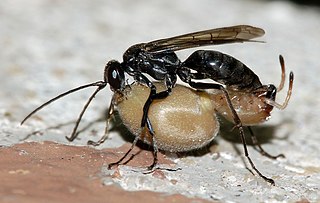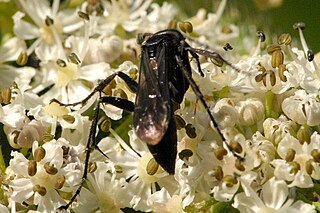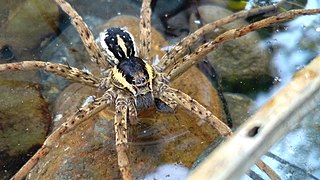
A tarantula hawk is a spider wasp (Pompilidae) that preys on tarantulas. Tarantula hawks belong to any of the many species in the genera Pepsis and Hemipepsis. They are one of the largest parasitoid wasps, using their sting to paralyze their prey before dragging it to a brood nest as living food; a single egg is laid on the prey, hatching to a larva which eats the still-living host. They are found on all continents other than Europe and Antarctica.

Wasps in the family Pompilidae are commonly called spider wasps, spider-hunting wasps, or pompilid wasps. The family is cosmopolitan, with some 5,000 species in six subfamilies. Nearly all species are solitary, and most capture and paralyze prey, though members of the subfamily Ceropalinae are kleptoparasites of other pompilids, or ectoparasitoids of living spiders.

Porrhothele antipodiana, the black tunnelweb spider, is a species of mygalomorph spider that lives in New Zealand. It is the most common and widespread of several species in the genus Porrhothele, and is especially common in the greater Wellington region where the vagrant mature males are often encountered in or around dwellings. This species is one of New Zealand's most studied spiders. In New Zealand, the common name "tunnelweb spider" is also often used to refer to members of the genus Hexathele. Neither should be confused with their distant relatives, the highly venomous Australian funnel-web spiders.

A wasp is any insect of the narrow-waisted suborder Apocrita of the order Hymenoptera which is neither a bee nor an ant; this excludes the broad-waisted sawflies (Symphyta), which look somewhat like wasps, but are in a separate suborder. The wasps do not constitute a clade, a complete natural group with a single ancestor, as bees and ants are deeply nested within the wasps, having evolved from wasp ancestors. Wasps that are members of the clade Aculeata can sting their prey.

Episyron quinquenotatus, the white-trimmed black wasp, is a North American species of pompilid spider hunting wasp.

Auplopus carbonarius is a spider wasp of the family Pompilidae. Uniquely among the British group it constructs a nest of barrel-shaped cells in which spiders are stored and the larvae develop. The British common name is sometimes given as the potter spider wasp or the yellow-faced spider wasp.

Anoplius nigerrimus is a species of spider wasp, or pompilid, and is the type species of the genus Anoplius.

Priocnemis monachus is a species of spider wasp endemic to New Zealand, where it is known as the black hunting wasp or ngaro wīwī. It hunts large tunnelweb or trapdoor spiders, paralysing them with its sting and storing them in burrows for its larvae to eat alive. It is the largest member of the family Pompilidae in New Zealand.

Cryptocheilus australis, the golden spider wasp, is an Australian pepsid spider wasp that was accidentally introduced to New Zealand around 1960.

Agenioideus cinctellus is a spider wasp of the subfamily Pompilinae with a Palearctic distribution.
Priochilus captivum is a species of neotropical spider wasp in the family Pompilidae. It is native to Central and South America. It was first described by the Danish zoologist Johan Christian Fabricius in 1804.

Anoplius viaticus, commonly known as the black-banded spider wasp, is a species of spider wasp. These wasps are known as spider wasps because the females capture spiders to provide their offspring with food. The paralysed spider is cached in a burrow, the wasp lays an egg on it, and when this hatches, the developing wasp larva consumes the spider. This species is found in sandy heathland across most of Europe.
Anoplius infuscatus is a species of spider wasp found mainly in Eurasia.

Tachypompilus analis, the red-tailed spider wasp is a species of spider wasp found in most of tropical and subtropical Asia, north to Japan. These spider wasps often hunt huntsman spiders.

Tachypompilus ferrugineus, the rusty spider wasp, red-tailed spider hunter, or sometimes red-tailed spider wasp is a species of spider wasp from the Americas. It preys mainly on wandering spiders, especially wolf spiders.

Poecilopompilus algidus is a species of spider wasp which is widespread in the Americas.

Pepsis grossa is a very large species of pepsine spider wasp from the southern part of North America, south to northern South America. It preys on tarantula spiders, giving rise to the name tarantula hawk for the wasps in the genus Pepsis and the related Hemipepsis. Only the females hunt, so only they are capable of delivering a sting, which is considered the second most painful of any insect sting; scoring 4.0 on the Schmidt sting pain index compared to the bullet ant's 4.0+. It is the state insect of New Mexico. The colour morphs are the xanthic orange-winged form and the melanic black winged form. In northern South America, a third form, known as "lygamorphic", has a dark base to the wings which have dark amber median patches and a pale tip.

Pison spinolae, commonly known as mason wasp, is a solitary wasp of the family Crabronidae, found throughout New Zealand.

Allochares azureus is a species of spider wasp from the family Pompilidae, it is the only member of the monotypic genus Allochares. It occurs in the southern part of North America and is a specialist parasitoid of the Southern house spider.

Dolomedes dondalei is a species of large fishing spider endemic to the main islands of New Zealand. It is a nocturnal hunter, feeling the water surface for vibrations, and catches insects and even small fishes – the only New Zealand Dolomedes species able to do so.




















